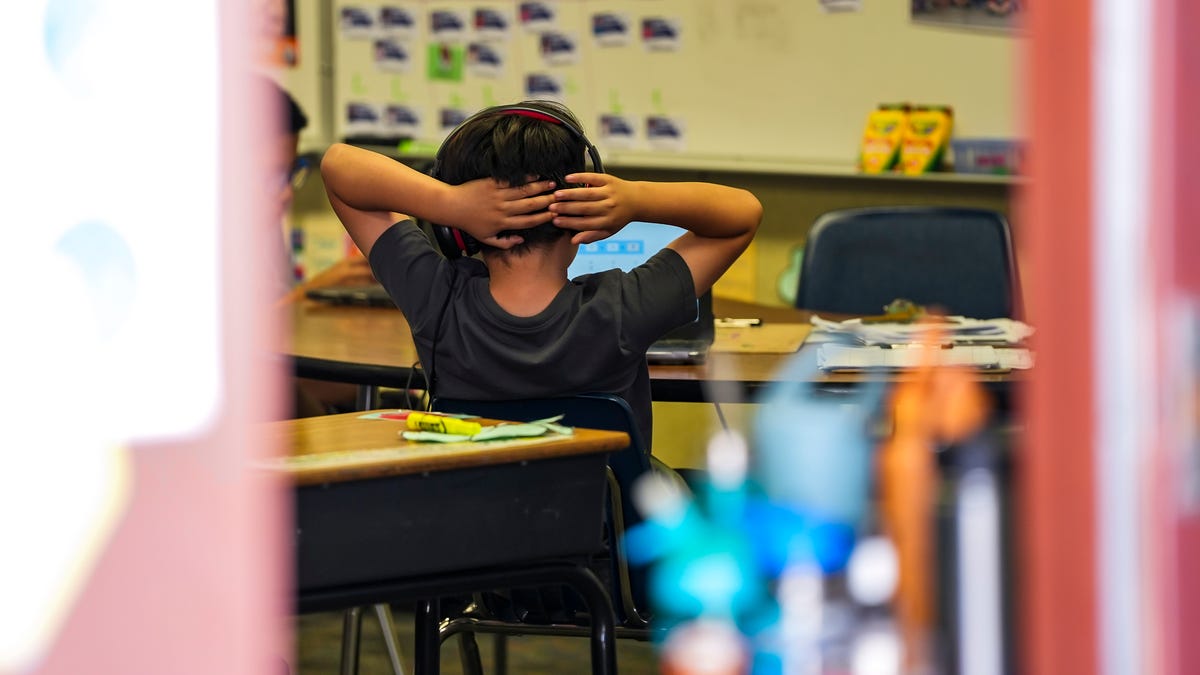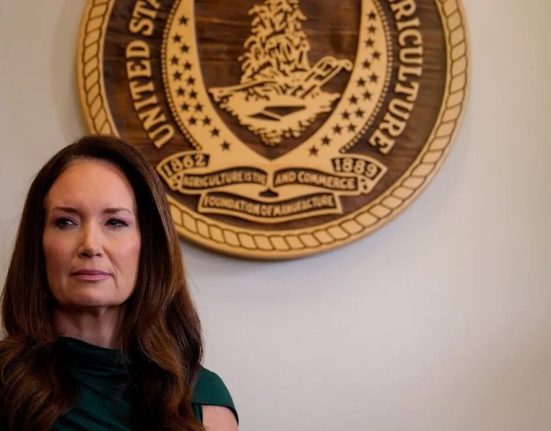The federal funding freeze could cost the Coachella Valley’s K-12 school districts at least $6 million, forcing districts to dip into reserves and rethink staffing.

How are schools funded in California? Here’s what you need to know
An overview of the funding sources for K-12 schools in California, including the Local Control Funding Formula, local property taxes, and federal contributions.
At least $6 million in federal funding that helps teach English learners, train teachers, and run after-school programs is at risk for the Coachella Valley’s three K-12 school districts after the Trump administration moved to freeze grants nationwide.
In California alone, a projected $811 million in education grants remains on hold, tied to five federal programs Congress allocated to support students, according to an analysis by the Learning Policy Institute.
That amount — roughly 16.5% of the state’s total funding from the U.S. Department of Education — could disrupt budgets already approved for the 2025-26 school year, a fiscal year that began July 1.
What happened
Just one day before the federal Title funds were set to be awarded, the U.S. Department of Education warned lawmakers on June 30 that states wouldn’t be getting their funding estimates on time.
The U.S. Department of Education provided little explanation or timeline for when, or if, the funds would be distributed. In its notification, the agency said only that it “remains committed to ensuring taxpayer resources are spent in accordance with the President’s priorities and the Department’s statutory responsibilities.”
In a press release, State Superintendent of Instruction Tony Thurmond said President Trump sidestepped the democratic process by blocking funding that had already been allocated, rather than working through Congress to propose cuts.
“California and other states have already filed suit against the Trump Administration based on prior acts to unlawfully withhold funding because we refuse to conform with the President’s political ideology,” Thurmond said. “Courts have already taken action in our favor in these cases. California will continue to pursue all available legal remedies to the Trump Administration’s unlawful withholding of federal funds appropriated by Congress.”
Riverside County Office of Education — which also oversees Don F. Kenny Regional Learning Center in Indio and Palm Springs Community School — said it is waiting for further guidance from state and federal officials.
In the meantime, RCOE has scheduled a Zoom meeting with district superintendents for Tuesday, July 15. Staff from its fiscal services, government relations, educational services, and communications teams plan to share available information and answer questions as districts navigate the ongoing uncertainty.
Which Title programs are affected
The funding freeze impacts five federal Title programs that provide targeted support for underserved students. These grants are awarded annually and are a core part of how states and districts address academic disparities, support teachers, and expand access to enrichment and wellness services:
- Title I-C supports the educational needs of students whose families are migrant workers;
- Title II-A funds programs to improve the quality and effectiveness of teachers;
- Title III-A provides supplementary academic support and educational services to students learning English;
- Title IV-A provides funding for enhanced classroom technology, student wellness, and enrichment programs that support a well-rounded education; and
- Title IV-B supports after-school and summer programs, including family-based services aimed at preventing child maltreatment and supporting student development outside of school hours.
How local K-12 school districts in the Coachella Valley could be impacted
Coachella Valley Unified School District
Superintendent Frances Esparza said the freeze worsens Coachella Valley Unified’s $60 million budget deficit, which has already triggered staff layoffs. She acknowledged the district could lose at least $2 million in Title funding, similar to what neighboring districts face.
The freeze threatens multiple programs and could lead to further layoffs, especially for staff paid through those funds, as CVUSD cannot afford to absorb the loss.
“We’re hoping that we don’t have to do a big layoff, but at this point, it’s really hard,” Esparza said. “Because of our fiscal stabilization plan we must follow, we don’t have the option to keep them until next year and use LCAP money because now it’ll be supplemented. We can’t do that. We don’t have that type of budget yet.”
Although the March 15 deadline for issuing reduction-in-force notices has passed, Esparza noted the district could still issue 60- or 90-day layoff notices under certain provisions. However, she said CVUSD will first try to reassign affected employees, such as those hired under the migrant education program, which has effectively lost its funding.
Coachella Valley Adult School, which graduates 500 to 600 students each year, is also “in jeopardy,” Esparza said.
Since 1952, the adult school has offered high school diploma programs, GED preparation in English and Spanish, as well as citizenship classes to adults across the valley. The superintendent said if the school is forced to close, its teachers — who hold credentials through CVUSD — could transfer to other school sites within the district. She added that the district would also seek support from CVAS’s partners, Desert Sands Unified and Palm Springs Unified school districts, to ideally help keep at least two-thirds running.
The district also warned that the freeze could disrupt or reduce:
- Stipends for induction coaches who provide support and mentorship to new teachers;
- Student access to College Board exams, like the PSAT and AP tests;
- Support for students dually enrolled at College of the Desert; and
- Student support services tied to compliance with the McKinney-Vento Homeless Assistance Act, which helps remove educational barriers caused by youth homelessness.
At the board meeting on Thursday, June 26 — days before the Trump administration formally announced the freeze — CVUSD trustees had already expressed concern about the looming threat to federal education funding.
“There are federal cuts being made. If there are schools that have the word ‘migrant,’ if there are schools that have the word ‘dual language,’ those are on the table in Washington, D.C., and those are being cut,” Trustee Thomas Tortez Jr. said.
He encouraged community members to contact elected officials and speak out against what he described as discriminatory budget decisions.
Desert Sands Unified School District
Desert Sands Unified School District said it receives funding from four of the five affected federal programs — all except Title IV-B — and could lose about $2.27 million, broken down as follows:
- Roughly $153.6K under Title I-C (migrant education);
- Roughly $664.5K under Title II-A (teacher training);
- Roughly $684K under Title III-A (English learner support); and
- Roughly $771.6K under Title IV-A (student wellness and enrichment).
DSUSD has 35 positions across the district that are partially funded by the affected federal programs, along with three fully funded roles. Most of the impacted positions are certificated staff, as well as a few classified positions. Salary coverage for these employees ranges between 5% and 50%, said Jan Diaz, the district’s communications specialist, in an email.
The district expects to sustain services through the 2025-26 school year using reserves and other funding sources, but some reductions would still be required.
“Looking beyond that point, we will need to closely evaluate each expenditure to determine whether ongoing services can be sustained,” Diaz said. “This will require a thoughtful and strategic review of all programs and funding commitments to ensure long-term fiscal stability.”
Palm Springs Unified School District
About $2.13 million in funding from three Title programs is at risk for Palm Springs Unified, broken down as follows:
- Roughly $768K under Title II-A (teacher training);
- Roughly $675K under Title III-A (English learner support); and
- Roughly $686K under Title IV-A (student wellness and enrichment).
The funding freeze threatens to disrupt several key programs, but PSUSD plans to use carryover funds from prior years to help sustain services in areas such as:
- Title II-A funds support two teachers on special assignment and the district’s recruitment and residency program. PSUSD expects to rely on $1.15 million in carryover from prior years to fully cover expenses for the 2025-26 school year;
- Title III-A funds help provide a teacher with special assignments, training for teachers and aides in English Language Development, software licenses, field trips, and transportation to serve the district’s 5,231 English learners. PSUSD plans to use about $385K in carryover from prior years to cover roughly half of the 2025-26 school year’s expenses.
- Title IV-A funds support student wellness and enrichment efforts, including two mental health therapists, a dual immersion teacher, and a teacher on special assignment, as well as teacher training. PSUSD expects about $326K in carryover from prior years to cover about half of the 2025-26 school year’s expenses.
“That is assuming we will still be allocated our carryover,” Simmons said in an email.
Previous reporting by USA Today was used in this story.
Jennifer Cortez covers education in the Coachella Valley. Reach her at jennifer.cortez@desertsun.com.







